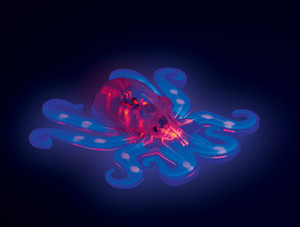
Harvard University
Octobot: fluorescent dyes, with oxygenated water as fuelHarvard UniversityLacking rigid circuit boards or motor coordination systems, the Octobot is a soft-bodied robot that mimics an octopus. Developed at Harvard under the coordination of Professor Robert Wood, the Octobot is a proof of concept robot that opens new frontiers in robotics. Three methods were used to build it: soft lithography, molding, and 3-D printing. A system of internal micro-channels was used in making the body (Nature, August 26, 2016). The Octobot runs on oxygenated water, also known as hydrogen peroxide. A platinum catalyst produces a chemical reaction that transforms the hydrogen peroxide into gas, which flows into micro-channels to inflate actuators that resemble tiny balloons, inside the Octobot’s arms. This reaction is what makes the robot move. A printed circuit with a special ink for conducting electrons works like a simple electronic oscillator, emitting repetitive pulses and controlling the transformation of liquid hydrogen peroxide into gas. When full, the oxygenated water reservoir accounts for half of the Octobot’s weight. Fluorescent dyes are pumped into the robot so the device’s internal features are easier to visualize.
Republish